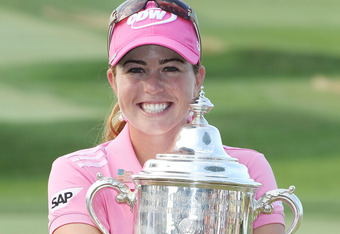
If ever there were three winners that make you feel good about the game, they are Paula Creamer, Edoardo Molinari and Steve Sticker.
Creamer was not expected to do well at the Women’s US Open at Oakmont CC. She was still recovering from surgery on her left thumb, could only hit 40 practice balls each day and had come up short in prior US Opens. But on Sunday Creamer, aka Pink Panther, showed us once again to beware the injured golfer, beware the golfer who can hit fairways, and beware the winner with a shopping list.
Two keys to her victory were tips from Arnold Palmer who knows a thing or two about Oakmont. They had played a charity function on Wednesday. When she asked him what was the most important thing about Oakmont, Palmer’s answer was no three putts and to keep her head down the whole time.
“I listened to that,” she said, adding that she still had a few three-putts. “I really tried to keep my head down as long as I could. Looking up, you can start to see a lot of crazy things. You know, there's a lot going on out there. I tried to make it as simple as I could.”
The biggest surprise is that she did not look at a leaderboard on the final round. When her caddie Colin Cann told her she should lay up on the drivable par four 17th , she suspected that she was in good shape.
In the end, Creamer said pars as much as the birdies helped her to victory. “They're never gonna kill you in an Open championship,” she explained. “If you get birdies, that's like getting a shot and a half to the field.”
With her victory secured, first on Creamer’s to do list is to buy a Birkin bag.
“It's like a really crazy bag,” Creamer explained to a room of mostly male journalists who hadn’t a clue as to what it was. “The waiting list is like years. We'll see. It's so bad. I know.”
Birkin bags are named after an actress, Jane Birkin. They are hand made. However, should Creamer want a faster track to bag happiness, new ones are available on eBay from $995 to $62,995.
Second on her list is skydiving with her father who was a military pilot. Hmmm. Birkin bag and skydiving. This is a new definition of a US Open champ.
Steve Stricker is the guy every mom wants to feed apple pie. He’s Opie, one of the Hardy Boys, a Mouseketeer. When he wins, even over a guy who threw a 59 at him, it’s un-American not to be happy.
Stricker is so nice he can have a hard time closing out victories, even with a six shot edge going into the final round, which is he had Sunday. In the end, he had a two-shot edge over Paul “ Mr. 59” Goydos, just as his did over Luke Donald at the Northern Trust earlier this season.
Stricker had a chance at the 72-hole scoring record which stands at -31, held by Ernie Els, although it was on a par 73 course, but he was unable to go low.
“I wasn't the same player as I was for three days, for sure, today,” Stricker said about his round. “You're just afraid to make a mistake, and that's hard to play golf that way.”
The lowest he got in relation to par was -27. His final round 70, one under par, gave him -26 on a par 71 course. He was only worried about the victory, not about records of any kind.
“I think it's just human nature that you don't want to screw up, and it's hard to overcome,” he continued. “I still had the thought if I shoot 2 or 3-under, they're going to have to shoot 9-under to catch me, and that's a heck of a round.”
Stricker made an important putt on the 17th for birdie to give him a little breathing room on the 18th . But on the final hole, he hit a drive into the trees on the right. It looked like he might have a harder road to grab the trophy.
“I was trying to hit it in the fairway off the tee,” he said about the errant shot. “I'm thinking to myself, you know, bogey is going to force him to make a birdie, and that's one heck of a hole to try to make a birdie on. So after I hit the tree and my objective was just to get it down there where I could get my third shot on the green and make a five and force him to make a birdie. You know, I don't have to make it -- it doesn't have to be pretty. I just wanted to win, and fortunately it worked out.”
At the Barclays Scottish Open, Edoardo Molinari, former US Amateur champion, got his first European Tour victory in windy, rainy conditions, beating veteran Darren Clarke.
“When I saw the conditions this morning, you could have shot any number today to be honest,” Molinari said. When we teed off, it was so windy that I thought I didn't have any chance against Darren because he's a great player when conditions are like that.”
As it turned out, it was Clarke who could not stay with Molinari. The question was, would Molinari’s victory in Scotland bump the World Cup matches off the front pages in Italy.
“I saw one of the first pages in the newspaper this morning,” Molinari said about reporting after his third round. “There was a small picture with about this much on the first page ( small amount of coverage) , and so I think that tomorrow there will be a bigger picture and probably big comments.”



